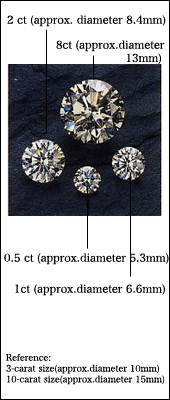Size is an important element of quality. Size adds to the beauty of a gemstone, and a large gemstone is always impressive. Yet the interesting thing about size is that we cannot assume that all small gemstones lack beauty, or that all large ones are beautiful. Beauty changes with size, and the way that it manifests itself also changes. When it comes to enjoying the three-dimensional beauty that a faceted cut creates, however, large-sized gemstones are far superior to smaller ones.
The untreated Myanmar sapphire to the right boasts a rich blue, despite its high tone level of 7. Its large size allows for areas of lighter tones within the mosaic pattern, giving it balance and bringing out the gemstone’s beauty. More important than the rarity of large-sized gemstones is their unique beauty, which makes them truly precious.
The deeper the color on a gemstone, the more beautiful it should appear, but a gemstone that lacks sufficient area and volume will just look darker. What is a beautiful deep color in a large gemstone will end up unattractively dark in a smaller one. Large gemstones are capable of taking such a deep color and separating it into a wide range of intermediate tones, incorporating these into the mosaic pattern. This is true depth of color, which is the essence of colored stones. Large gemstones are beautiful because they have this expanded depth of color.
The small heated Pailin sapphires to the eight have a tone level of 4. At this size and tone level, it is a material that is capable of exhibiting beauty as a continuous line if gemstones, and a number of these will be grouped together when used in gemstone-oriented adornments. Small stones with tone levels of 6 or 7 appear dark and do not show a mosaic pattern, making them unsuited for use in jewelry.
The Quality Scales presented in this book show the three quality zones for gemstones, mostly in sizes that are used as the main stones in jewelry. Depending on size, however, the stone’s optimum tone level may vary by one or two levels higher or lower. Ideally, the same shape, cut, and size should be used for comparison, but in reality a one-carat master stone will be used when observing both 10-carat gems and 0.1-carat ones.
During the 1970s, I had numerous discussions with cutters in New York and Antwerp regarding what size of round brilliant cut diamond showed the most beautiful brilliance. At five carats, 58 facets seem to be insufficient, leaving one wanting a few more. On the other hand, one doubts whether a stone of 0.1 carat or less actually needs that many facets. Some of the cutters said that a round brilliant of two-carat size or so had the best balance and was the most beautiful, and I remember agreeing with them. |
|
In diamonds over 5 carats there is a noticeably large number of pear shapes. Slightly long pear shapes look especially large, making them quite popular. In rounds over two carats, the balance between brilliance and dispersion changes, with brilliance dominating. The large appearance of pear shapes is more impressive than the brilliance of rounds.
When comparing a 0.01-carat round brilliant cut with 58 facets to a single cut with 18, the single cut shows stronger brilliance. No matter how fine the rough material used in a marquise cut diamond is, sufficient beauty cannot be brought out in a stone of less than 3.5 x 1.8 millimeters (about 0.05 carat). Each cutting style has a limit to the size at which it can draw out the beautiful brilliance of a stone. One must understand that there are optimum cutting styles for gemstones, depending on their size.
There are many size-related factors that affect value. For example, when setting a gemstone that is being matched to a specific design, there must be an exact harmony between size and quality. Also, gemstones cut to standard sizes to deal with mass production will have a higher value. In such a case, extra weight loss maybe tolerated to make the needed size. As another example, instead of cutting the largest stone possible, one piece of rough material may be cut into several stones to satisfy market demand. In that case, what could have been a deep color in a single piece may end up light in tone because the crystal was cut into small stones. In gemstones such as aquamarine that normally occur as light-colored crystals, small stones with a dark tone are valuable.
It is documented that since ancient times, gems have been sold by weight. Even now, the age-old weight measurement of the carat is used, for both accuracy and convenience. However, no one purchases a gemstone because of how heavy it feels. Instead of saying, “Do you have something heavier?” the buyer asks, “Do you have something bigger?” When considering the beauty, quality, and value of gemstones, the standard for judging size is not the stone’s weight, but its measurements. |

|
|